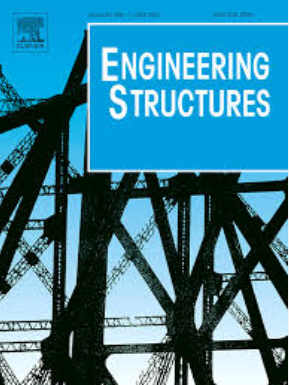描述用木材加固的URM墙抗震性能的解析公式
IF 5.6
1区 工程技术
Q1 ENGINEERING, CIVIL
引用次数: 0
摘要
未加筋砌体结构在大强度地震作用下易发生局部或整体面外倒塌。用机械扣件在砌体表面安装木材加固是一种可逆的、有效的加固方案,可显著改善砌体墙体的面外响应。提出了一种分析公式,可以描述用木材强背进行地震改造的未加固砌体墙的面外行为,并利用极限分析定理建立横向能力曲线和对砌体墙、木材强背和加固墙的紧固件组件的要求,从而使改造干预的设计成为可能。这些分析预测通过五个全尺寸砌体墙试验的实验数据进行了验证,并与使用SAP2000软件开发的数值模型的模拟结果进行了比较,并采用了简化的微观建模方法。解析导出的载荷作用与实验值一致(误差<;5%),与数值变形结果一致(误差<;10%)。然后报告各种改造墙配置的预期性能,作为对改造解决方案的一般考虑的支持。本文章由计算机程序翻译,如有差异,请以英文原文为准。
Analytical formulation describing the behaviour of URM walls seismically strengthened using timber strong-backs
Unreinforced masonry structures are vulnerable to seismic actions and frequently exhibit partial or global out-of-plane wall collapse when subjected to large intensity earthquake shaking. The installation of timber strong-backs connected to the masonry surface with mechanical fasteners is a reversible and effective strengthening solution that considerably improves the out-of-plane response of masonry walls. An analytical formulation is presented that enables the out-of-plane behaviour of unreinforced masonry walls seismically retrofitted with timber strong-backs to be described, with limit analysis theorems being utilised to establish the lateral capacity curve and the demands on the masonry wall, on the timber strong-backs, and on the fastener components of the retrofitted walls, thereby enabling the design of retrofit interventions. These analytical predictions were validated using experimentally derived data from five full-scale masonry wall tests and were also compared with simulations obtained from a numerical model developed using the software SAP2000 and adopting a simplified micro-modelling approach. Analytically derived load actions were consistent with experimental values (errors < 5 %) and were compatible with the numerical deformation results (errors < 10 %). The expected performance of various retrofitted wall configurations is then reported as support for general considerations regarding the retrofit solution.
求助全文
通过发布文献求助,成功后即可免费获取论文全文。
去求助
来源期刊

Engineering Structures
工程技术-工程:土木
CiteScore
10.20
自引率
14.50%
发文量
1385
审稿时长
67 days
期刊介绍:
Engineering Structures provides a forum for a broad blend of scientific and technical papers to reflect the evolving needs of the structural engineering and structural mechanics communities. Particularly welcome are contributions dealing with applications of structural engineering and mechanics principles in all areas of technology. The journal aspires to a broad and integrated coverage of the effects of dynamic loadings and of the modelling techniques whereby the structural response to these loadings may be computed.
The scope of Engineering Structures encompasses, but is not restricted to, the following areas: infrastructure engineering; earthquake engineering; structure-fluid-soil interaction; wind engineering; fire engineering; blast engineering; structural reliability/stability; life assessment/integrity; structural health monitoring; multi-hazard engineering; structural dynamics; optimization; expert systems; experimental modelling; performance-based design; multiscale analysis; value engineering.
Topics of interest include: tall buildings; innovative structures; environmentally responsive structures; bridges; stadiums; commercial and public buildings; transmission towers; television and telecommunication masts; foldable structures; cooling towers; plates and shells; suspension structures; protective structures; smart structures; nuclear reactors; dams; pressure vessels; pipelines; tunnels.
Engineering Structures also publishes review articles, short communications and discussions, book reviews, and a diary on international events related to any aspect of structural engineering.
 求助内容:
求助内容: 应助结果提醒方式:
应助结果提醒方式:


